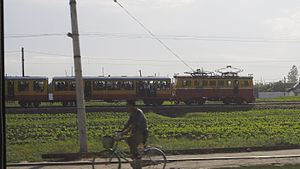Native name 신흥선(新興線) Termini HamhŭngPujŏnhoban | Status Operational Stations 16 | |
 | ||
Type Heavy rail, Passenger/Freight railRegional rail Opened 10 June 1923 (Hamhŭng—Yŏnggwang)25 August 1923 (Yŏnggwang—Changp'ung)1 October 1926 (P'ungsang—Sinhŭng)1 February 1928 (Sinhŭng—Songhŭng)10 September 1932 (Songhŭng—Pujŏnhoban) | ||
The Sinhŭng Line is an electrified railway line of the North Korean State Railway running from Hamhŭng on the P'yŏngra Line to Pujŏnhoban on Lake Pujŏn. Between Hamhŭng and Sinhŭng, a distance of 40.9 km (25.4 mi) the line is standard gauge, but the remaining 50.6 km (31.4 mi) from Sinhŭng to the terminus at Pujŏnhoban is 762 mm (2 ft 6 in) narrow gauge; the narrow gauge section is also electrified. There is also an electrified narrow-gauge branch, the Sŏho branch, from West Hamhŭng to Sŏho. Though primarily an industrial railway connecting to the Pujŏn River hydroelectric power plant, it also plays an important role in passenger transportation in the region. There is a 550 m (1,800 ft) section between Songhŭng and Pujŏllyŏng that is cable-hauled.
Contents
History
During the Japanese colonial era, the privately owned Sinhŭng Railway built a narrow gauge railway, the Hamnam Line (not to be confused with the line of the same name of the Chosen Magnesite Development Railway, nowadays called Kŭmgol Line), to serve the newly built Pujŏn River hydroelectric power plant and to exploit forestry and other resources in the area. When complete, the Hamnam Line ran from Hamhŭng to Hamnam Sinhŭng (nowadays called simply Sinhŭng) via Oro (nowadays Yŏnggwang) , with a branch from Oro to Sang'tong. Later, the Sinhŭng Railway opened the Songhŭng Line from Sinhŭng to Pujŏnhoban. The Sinhŭng Railway was bought by the Chosen Railway on 22 April 1938.
The Sŏho Branch was also originally opened by the Sinhŭng Railway. Originally called the Namhŭng Line, it was opened in three sections between 1934 and 1936.
After the establishment of the DPRK and the nationalisation of its railways, the Hamnam Line was split up, with the Hamhŭng - Oro - Sinhŭng section becoming the Sinhŭng Line, and the Oro - Sangt'ong section becoming part of the Changjin Line. At the same time, the Songhŭng Line was merged into the Sinhŭng Line, extending it to its current length. Originally built entirely as a narrow gauge line, frequent accidents on the line led the Korean State Railway to convert the Hamhŭng—Sinhŭng to standard gauge for greater safety and increased transportation capacity. After the regauging of this section, West Hamhŭng station was disconnected from the Hamhŭng—Sinhŭng, remaining as northern terminus of the line to Sŏho. Electrification of the line to Pujŏnhoban was completed in 1992.
Services
The primary outbound freight shipped on the Sinhŭng Line is wood; potatoes and metals are also shipped out. Goods arriving onto the line from elsewhere include coal (anthracite and bituminous), fertiliser, aquatic products, grains and cement.
A pair of local passenger trains, 880/881, operate on the standard gauge section of this line between Hamhŭng and Sinhŭng; there are also passenger trains on the Sŏho branch.
Route
A yellow background in the "Distance" box indicates that section of the line is not electrified; a pink background indicates that section is 762 mm (2 ft 6 in) narrow gauge; an orange background indicates that section is non-electrified narrow gauge.
Sŏho Branch
Electrified, 762 mm (2 ft 6 in).
